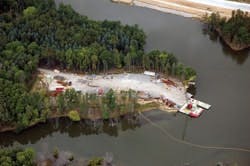2010 Top 10 Roads - No. 4
In a time when environmentally conscious construction has more relevance than ever before, the I-80 Widening at Meander Reservoir deserves special recognition for its innovative sustainable features.
One of the largest and most challenging projects in the history of the Ohio Department of Transportation (ODOT) District 4-0, the $95.3 million job improved safety and convenience for the traveling public and featured a spill-containment system design that protects drinking water for all of Mahoning and Trumbull counties.
The project took place between March 2006 and September 2009 with Anthony Allega Cement Contractor and Great Lakes Construction Co. serving as the contactors. Designed by Gannett Fleming Engineers and Architects P.C., the job entailed widening 4.5 miles worth of I-80 from S.R. 11 to the Ohio Turnpike from four to six lanes. It also widened shoulders and created longer merge lengths.
The need for spill containment arose out of concern for drinking-water quality, considering there had been tanker-truck accidents—in one instance a truck went over the side of the bridge and into the reservoir.
“They were concerned with hazardous material spills,” Paul Coblentz, P.E., Gannett Fleming Inc., told Roads & Bridges. “So they worked with ODOT and requested that as one facet of the project, some type of system be designed and constructed to contain any spills. The existing bridges were flat; they have many joints and any storm water that falls on the bridges just drops down into the reservoir through scuppers and down spouts.”
The new bridges crest midway over the reservoir, allowing any material spilled from vehicles to drain into inlet pipes and roadside ditches away from the bridges. The spillage then runs into two containment basins located at low points on both ends of the bridges. Each basin has shutoff valves that prevent contaminated materials from entering the drinking water reservoir.
The pavement utilized was a 13-in. portland cement concrete. The mix was standard ODOT, and subgrade work involved 12-in.-deep cement-stabilized subgrade in selected areas. In addition, 8,800 cu yd of grout was pumped below the subgrade to fill voids in the abandoned mines under the interstate.
The most challenging aspect of the project, Coblentz said, was performing the work under heavy traffic.
“We could not shut down any of the interstate,” he said. “So the best we could do was move traffic lanes from side to side and work around them.”
The project team overcame a slew of other challenges as well.
“We had to coordinate in our office many different groups of engineers—bridge, roadway, environmental, geotechnical, traffic engineers—so there was a lot of coordination required in our office and then, likewise, coordination with ODOT and all of their roadway and bridge and environmental and traffic and right-of-way people.”
“With the community and traveling public in mind, ODOT worked with local officials and emergency responders to design this project to achieve everyone’s goals,” ODOT District Deputy Director Eric Czetli said.
